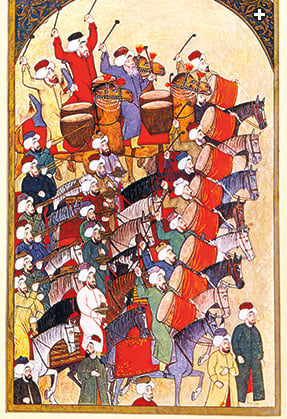 |
| alfrEdo daglI ortI / art archIvE / art rEsourcE |
 |
| bob gomel / time life pictures / getty images |
| European orchestras first used bass drums and cymbals in 1760, 40 years after
this miniature, top, depicted a mounted mehter band. It shows six boru (trumpets), six pairs of zil (cymbals), eight davul (bass drums) and three pairs of kös (tympani). |
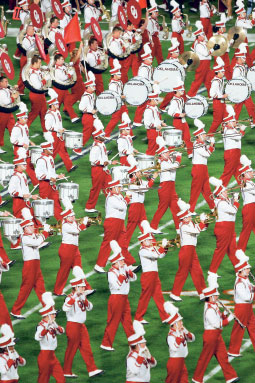 |
| jamie squire / getty images |
| Echoing a distant musical ancestor with precision marching and blood-stirring, heart-pounding music, some of today’s best-known descendants of mehter are the American marching bands that symbolize local pride at football games and in holiday parades. |
 |
| fatih saribas / reuters / corbis |
| European military bands, such as the British drum corps that plays for the annual Trooping of the Colour, adopted Turkish instruments but avoided Turkish melodies. |
You hear its echo when the cymbals crash and bass drums boom during a marching band's performance at a football game. It reverberates down the centuries when an orchestra marks the final measures of Beethoven's Ninth Symphony. And it resounds when a rock band blasts a concert hall. It's the unmistakable sound print—the musical DNA—of the colorful mehter musicians, master bandsmen of the Ottoman Empire.
Their music once spurred on Turkish soldiers, serenaded sultans and inspired mystics. Europeans lampooned them at first, and then adopted their signature crash and boom, transforming the sound of western bands and orchestras.
Mehter (pronounced meh-tare and derived from the Persian word for “superior”) originally referred to all kinds of high-ranking servants. It is said that the Seljuk leader Alaeddin gave a forerunner of the mehterhane, or “mehter band,” to the first Ottoman sultan, Osman i, in 1289 and that the sultan stood whenever the band played, in honor of Alaeddin. That custom died out, but the mehterhane became a symbol of the Ottoman Empire and the sultan himself. The bandsmen were part of the sultan’s kapıkulu, or “household,” and were among the highest-paid men on the imperial staff. By around 1600, people associated the term mehter with the sultan’s musicians.
Mehter musicians were a key part of the soundscape of the Ottoman Empire, which lasted from 1299 until 1923, dominating the Middle East and reaching into Europe at its height. There were also sophisticated court composers and virtuosic players, Sufi music masters, church and synagogue cantors, itinerant bards and village bands. By the 1600’s, Turkish traveler Evliya Çelebi noted that the Ottoman Empire had 40 guilds of musicians, singers and instrument makers.
Europeans had many opportunities to hear mehter bands, for from the time the Ottomans conquered Constantinople in 1453 until 1699—a period known as the Turkish Wars—they worked to extend their power into eastern Europe, bringing their musicians with them into battle. One can only imagine the impression it made on Europeans who had never heard a crashing cymbal and bass drum played together before.
For example, a Prussian soldier who visited Constantinople with the Polish emperor Augustus ii in the early 1700’s recalled years later the discomfort caused by a mehter procession that passed his quarters each morning. It “split the ears with its incredible charivari,” he said.
He had no doubt heard several high-pitched zurnas, double-reed oboe-like instruments, playing the melody, sometimes alternating with a hearty chorus. Trumpets, or boru, played accent notes. And there were small kettledrums (nekkare), bass drums (davul) and crash cymbals (zil). The çevgan, a tall staff with a large metal crescent moon, festooned with bells and sometimes horsetails, added a jingling sound, probably between songs, to liven things up. If the sultan’s own band passed by, he would have also heard the waving thunder of the kös, camel-skin kettledrums played by musicians mounted on camels. Official bands had seven to nine players of each type of instrument, magnifying the effect of each.
Antoine Galland, translator of A Thousand and One Nights into French, was most impressed by the kös during his visit to Constantinople in 1672 and 1673. “What made everything tremble and shake was the thunder of four timbales [kettle-drums], larger than I have ever seen or heard, carried on camels.There was no one who was not only stunned by it, but whose whole body stirred inside and out.”

Even Turks could find the music overwhelming. “They raise such a din that Venus begins to dance and the skies resound,” Çelebi wrote of the mehter. When they passed by, “the noise of them presses men’s brains out of their mouths.”
Mehter bands were most famous for performing in battle to inspire the Ottoman infantry, the Janissaries, elite troops drafted as boys from the Empire’s non-Turkish territories. Today, mehter musicians remain a source of national pride in Turkey, where they’re associated with military music.
 |
| julian calder / getty images |
| This young visitor to the Turkish Military Museum’s regular mehter heritage performance in Istanbul might agree with the Prussian soldier who, in the early 1700’s, complained that the mehter band “split the ears with its incredible charivari.” |
To Mehmet Sanlıkol, a Turkish musician who grew up playing rock and jazz, mehter music is like “the sound of Led Zeppelin, Herbie Hancock’s Headhunters and James Brown.” But Sanlıkol, now a professional musician and a music professor in Boston, reveals in his book The Musician Mehters that their repertoire was much broader than just war songs.
As official state bands, they had regular imperial duties in Constantinople. They awakened people before the dawn call to prayer and gave concerts at night from castles and towers. They accompanied the sultan when he moved about the city and serenaded him while he was shaved. They entertained at ceremonies and celebrations and performed for state visitors and at promotion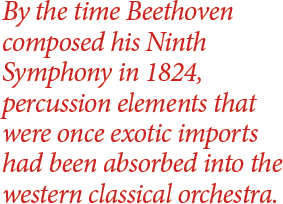 ceremonies. Ottoman ambassadors and provincial officials had their own, smaller mehter bands.
ceremonies. Ottoman ambassadors and provincial officials had their own, smaller mehter bands.
Along with martial music, the bands performed peşrev and sama‘i, stately instru-mentals that were also popular with other types of ensembles. Mehter groups also per-formed religious songs for pilgrims making the Hajj to Makkah.
Smaller, unofficial mehter bands played folk songs at weddings. One Turkish folk song goes, “I don’t care what happens as long as the mehter plays and the wedding goes on.”
Sufi brotherhoods also played mehter-style music, using cymbals and the kuddum, a kettledrum larger than the nekkare. Sultan Selim iii (1796–1808) lent his personal set of kös to the Istanbul Mevlevi lodge, of which he was a member.
Europeans incorrectly called mehterhane “Janissary bands,” Sanlikol points out, noting that Turkish historians never referred to them that way. He adds that mehter bandsmen always played on horseback in battle, whereas Janissaries were expressly forbidden to ride. Nevertheless, the name stuck.
When German poet Christian Schubart heard a mehter group playing in Europe in the mid-1700’s, he wrote that their music was “so warlike, that even cowardly souls throw out their chests.” He deemed its straightforward rhythms excellent for the military. “Each beat is delineated so strongly, and with such new manly accent, that it is well-nigh impossible to get out of step,” he noted.
 |
| dieter heinemann / westend61 / corbis |
 hen the Ottomans besieged Vienna for the second and final time in 1683 (the first siege was in 1529), mehter musicians accompanied them. Paul Rycaut, an English diplomat observing the battle, wrote, “On the 26th [of July], the Turks, designing to make a furious Assault, caused all their warlick Musick, such as Flutes, Cymbals, and brass Trumpets, which gave a shrill Sound, to play on their highest Notes to encourage their Soldiers to make the Onset.”
hen the Ottomans besieged Vienna for the second and final time in 1683 (the first siege was in 1529), mehter musicians accompanied them. Paul Rycaut, an English diplomat observing the battle, wrote, “On the 26th [of July], the Turks, designing to make a furious Assault, caused all their warlick Musick, such as Flutes, Cymbals, and brass Trumpets, which gave a shrill Sound, to play on their highest Notes to encourage their Soldiers to make the Onset.”
After their army’s defeat at Vienna, legend goes that the retreating mehterhane left their instruments on the field, and that’s how the Viennese picked up the bass drum and cymbals. But this ignores the fact that merchants and diplomats had visited Istanbul and written about the mehter musicians for centuries, fueling a fascination for all things Turkish. Europeans dressed as Turks for costume balls and parades and included Turkish characters in plays and operas. Street bands imitating the Turkish sound performed on the street corners of Vienna.
“That is a perfect example of how cultures do not exist in isolation, “says Dr. Robert Labaree, a professor at Boston’s New England Conservatory of Music and an expert on Ottoman music. “Even people who are in conflict basically shape the lives of everybody on the other side of the line.”
In 1699, the Turks and the Europeans signed the Treaty of Karlowitz, ending the Turkish Wars and dividing eastern Europe into spheres of influence. To mark the occasion, the Ottomans sent a mehter band to perform in Vienna for several days. In the decades that followed, Ottoman ambassadors appointed to western capitals brought mehter bands along.
The 18th century is remarkable for Europe’s craze for Turkish culture, known as Turquerie, or Turkomania. Dozens of operas were written with Turkish scenarios. Europeans smoked Turkish tobacco in Turkish pipes and drank Turkish coffee while wearing Turkish robes. Turkish characters and interludes appeared in otherwise unrelated ballets and plays. Aristocrats had their portraits painted in Turkish costume, decorated their private rooms with Turkish motifs and devoured the newly translated text of A Thousand and One Nights (which wasn’t Turkish).
Initially, the mehter sound was imitated as a kind of cartoon of Turkishness, the Middle East and the Orient, says Labaree. Yet within decades its percussion sound was absorbed, helping to transform both western military bands and orchestras.
Military bands were the first to embrace the mehter percussion sounds. In 1720, Sultan Ahmed iii sent Augustus ii of Poland an entire mehter band as a gift, and the Polish army thereafter adopted the Turkish band style. Not to be upstaged, Empress Anna of Russia obtained her own mehter band from Turkey in 1725, and had it play for the signing of the Russo–Turkish Treaty of Belgrade in 1739. Austria and France were next to adopt the Turkish military music style. By the late 1700’s, military bands in most of Europe played bass drums and cymbals. While European bands loved the Turkish percussion style, however, they never adopted Turkish melodies.
European bands also adopted the mehterhane’s çevgan, the staff with bells. The English called them “jingling johnnies”; the Germans named them schellenbäume, or “bell trees.” They came to signify a military regiment or unit and remained in some European bands until World War i. Indeed, German bands still use them today.
At first, Europeans imported Turkish musicians for these bands, and sent their own musicians to Turkey for training. They later turned to black musicians and had them perform wearing exotic Oriental costumes.
 merican military marching bands naturally adopted the band traditions of Europe. And as the popularity of marching bands expanded into civilian and school bands, the crashing cymbals and bass drums inherited from the mehter musicians marched into town parades and onto football fields.
merican military marching bands naturally adopted the band traditions of Europe. And as the popularity of marching bands expanded into civilian and school bands, the crashing cymbals and bass drums inherited from the mehter musicians marched into town parades and onto football fields.
Mehter music also took hold in opera. Composers wrote dozens of operas with Turkish themes and scenarios, and they included music that imitated mehter music. The first composer to use the Turkish crash cymbal in opera was Nicolaus Strungk in his 1680 opera, Esther. It was not until the 1760’s, however, when military bands in Europe had adopted the Turkish percussion sound and Turkomania was in full swing, that the overt use of the so-called Janissary-band sound reached the art music stage.
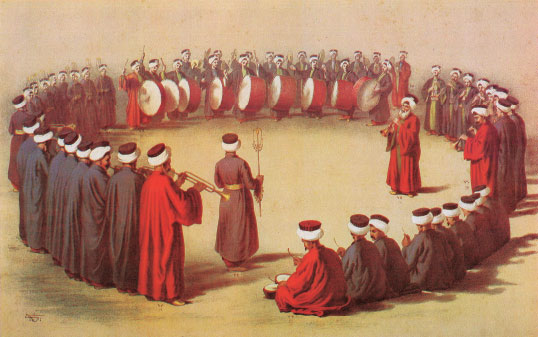 |
| courtesy mehmet sanlikol |
| Official bands did more than play for battle: They announced calls to prayer on special occasions, accompanied the sultan about the city and performed for state visitors. Other bands, such as the one shown above, performed religious songs for pilgrims making the pilgrimage, and for other religious occasions. Below: The thunderous kös drums were often mounted on camelback, in pairs. |
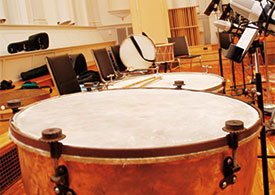 |
| john weston |
The first operatic performance of bass drum and cymbals together was in Christoph W. Gluck’s 1760 opera, Le Cadi Dupé. Mozart, composer of the most famous Turkish opera, The Abduction From the Seraglio, included the mehter sound in the overture and the “March of the Janissaries.” While composing it, he wrote, “You cannot imagine the difficulty of arranging an opera for military band, to make it fit for wind instruments without sacrificing any of the effects.”
European classical composers also began writing compositions in a melodic style called alla turca, their interpretation of Turkish music. Alla turca music included melodic ornamentation such as grace notes and “leaping thirds,” steady hypnotic meters (including the marching cadence “left, left, left right left”), repeated melodies
and frequent switching between major and minor keys. Alla turca compositions appeared in works by Mozart, Haydn, and Beethoven.
At the height of the Turkomania craze, piano manufacturers built a pedal for pianos called the “janissary” or “Turkish” stop that approximated the sound of a bass drum, cymbal crash, bells and rattles. Pianists loved to use it while playing Mozart’s Rondo Alla Turca, one of his most famous piano compositions.
By the time Beethoven composed his Ninth Symphony in 1824, the percussion elements that were once considered exotic imports from Turkey had been absorbed into the western classical orchestra.
The last movement of Beethoven’s Ninth features the alla marcia section, also known as the “Turkish” march, a thrilling passage with a tenor solo and male chorus, over a military percussion line with crashing cymbals and triangle. Dr. Mary Hunter, a music professor at Bowdoin College and an expert on 18th-century music, says it is impossible to say whether Beethoven was specifically referencing Turkish music, or a more general military style.
One need only listen to the final measures of Beethoven’s Ninth, however, to hear how neatly the mehter percussion sound had been folded into the orchestra. The symphony ends with a series of splendid cymbal crashes.
 hile European bands and orchestras were adopting mehter percussion sounds, mehter bands themselves were disappearing. In 1826, Sultan Mahmud ii dissolved the Janissary infantry corps and disbanded the mehterhane, hiring Italian band leader Giuseppi Donizetti to replace them. He modeled new military bands on the western style, abandoned the old mehter repertoire and replaced it with western marches—which, however, had mehter roots. “So what had left Turkey as an eastern import into the West came back to Turkey as a western import to the East,” Labaree explains.
hile European bands and orchestras were adopting mehter percussion sounds, mehter bands themselves were disappearing. In 1826, Sultan Mahmud ii dissolved the Janissary infantry corps and disbanded the mehterhane, hiring Italian band leader Giuseppi Donizetti to replace them. He modeled new military bands on the western style, abandoned the old mehter repertoire and replaced it with western marches—which, however, had mehter roots. “So what had left Turkey as an eastern import into the West came back to Turkey as a western import to the East,” Labaree explains.
Although the mehter bands disappeared, the cymbal makers who had supplied them for centuries did not. They started serving new markets in Europe and America. One company in particular took advantage of the changing times.
In the early 1600’s, the heyday of the mehter bands, an Armenian-Turkish metalsmith named Avedis lived and worked in the sultan’s palace. According to family legend, he was also an alchemist. When he discovered a recipe for making bronze cymbals stronger and thinner, the sultan granted him the title zildji, or “cymbal-smith,” awarded him 80 gold pieces and ordered him to make cymbals for the mehterhane. In 1623, the succeeding sultan released him from government service. Avedis formed his own company and continued to make cymbals for the mehter bands, as well as for the Armenian and Greek churches. Starting a family tradition, he passed on the secret formula for making lightweight bronze cymbals to his eldest son.
After the mehter bands were shut down, the Zildjian Company made cymbals to meet the needs of the western marching bands and orchestras. Avedis Zildjian II built a schooner and sailed to Europe to show the company’s products at international exhibitions. His cymbals won awards in Paris, London, Vienna, Bologna and even Chicago.
 |
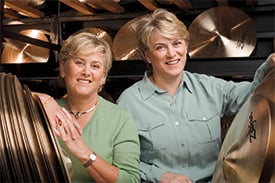 |
Top: courtesy zildjian company,
lower: tom kates / zildjian company |
Top: Avedis Zildjian stands by the door of the factory that, in 1929, became the home of his family business when he moved it to Boston from its roots in Turkey. There, the first Avedis had been the zildji (cymbal-smith) for the sultan’s mehter bands in the early 1600’s.
Above: Still based south of Boston, Craigie and Debbie Zildjian are the 14th generation to run the Zildjian Company, which now serves some 65 percent of the global market for cymbals. |
After the end of World War i and the end of the Ottoman Empire, company owner Aram Zildjian decided it was time to pass on the formula to the next generation. In 1929, he visited his nephew Avedis iii, who had moved to Massachusetts and was running a candy factory. They set up a cymbal plant in Quincy, south of Boston, near the sea—an ideal location, since part of the Zildjian process was to dip the newly forged bronze in cold water.
The year 1929 wasn’t an ideal time to establish a company in the us, given the looming Great Depression. Yet the Zildjians were lucky. They began operations just in time to capitalize on the popularity of jazz and swing. As his ancestors had once worked to satisfy the needs of mehter musicians and then marching bands and orchestras, Avedis iii sought out great jazz drummers. He asked them what they needed, and Zildjian made it for them. Later, the company forged larger cymbals to suit the big-band era. When the Beatles appeared on the Ed Sullivan Show in 1964, Ringo Starr played Zildjian cymbals, resulting in a backorder of 90,000 cymbals at the firm.
Today, Zildjian is the world’s leading cymbal maker, capturing approximately 65 percent of the market. It is also the oldest family-run business in the us, with the 14th generation of Zildjians—the current CEO is Craigie Zildjian—at the helm.
In 2011, Zildjian introduced two innovative sound-option products, named Gen16 after the current management’s grandchildren. The company digitized cymbal sounds from its legendary vault and launched a new line of acoustic-electronic cymbals that can be played at lower volumes, with several sound options. “My father insisted that we follow the music and, with Gen16, we’ve done just that,” says Craigie Zildjian.
In Turkey, meanwhile, mehter crashes and booms can be heard again. The Turkish Military Museum in Istanbul puts on regular mehter band concerts for tourists, performed by musicians who dress in traditional costumes and play primarily modern military marches. The idea of exploring the original mehter repertoire has not yet caught on in Turkey—but it has in Boston.
 n 2000, Mehmet Sanlıkol, then a graduate student at Boston’s New England Conservatory of Music, blasted some mehter music he’d downloaded from the Internet to spur himself on while playing the game of “Risk” with some friends. “The computer started looping the music,” he recalls. “While trying to understand it, I tuned in more, and by tuning in more, I got sucked in more. I went to bed with the sound of the zurna and davul in my head…and I couldn’t sleep.”
n 2000, Mehmet Sanlıkol, then a graduate student at Boston’s New England Conservatory of Music, blasted some mehter music he’d downloaded from the Internet to spur himself on while playing the game of “Risk” with some friends. “The computer started looping the music,” he recalls. “While trying to understand it, I tuned in more, and by tuning in more, I got sucked in more. I went to bed with the sound of the zurna and davul in my head…and I couldn’t sleep.”
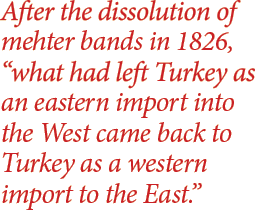
That introduction to mehter music led Sanlıkol into serious exploration of classical Turkish music. He learned to play instruments including the zurna and he formed Dünya, a nonprofit musical collective whose name means “world” in Turkish, Arabic, Persian and Greek, and which performs many facets of Turkish music dating from both during and after the Ottoman Empire. One of Dünya’s projects is what Sanlıkol calls a “learned” mehter band, the New England Drum and Winds Mehterhane. It is the only mehterhane in the world playing the pre-1826 repertoire.
“When I started digging deeper into Ottoman culture in general, I quickly discovered that the mehter repertoire in Turkey was dominated by relatively new music,” Sanlıkol recalls. “I found it so ironic that millions of Turks think that these western-influenced marches are at least a thousand years old.”
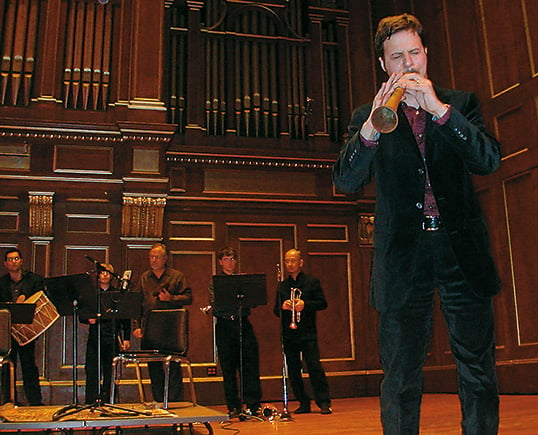 |
| julian calder / getty images |
| Although numbering far fewer musicians than the bygone royal Ottoman mehter bands, the Boston-based New England Drum and Winds Mehterhane may be the only ensemble in the world currently playing pre-1826 mehter music. That was the year Turkish mehter began to be overwhelmed, ironically, by the western styles of marches it had once inspired. |
Through his book, Dünya and his mehter band, Sanlıkol hopes that one day people will realize the full value of the mehter tradition. Dünya’s latest CD, A Story of the City: Constantinople, Istanbul, was nominated for a Grammy in 2011. The album presents a smorgasbord of Ottoman music and includes one of the old mehter battle pieces, “Çengi Harbi,” or “Cymbals of War.”
“I love the sound of mehter music. I love the power it has,” says Sanlikol, who is determined to share his native land’s music heritage. “The more I discover about mehter, the more I learn how diverse and cosmopolitan Ottoman society and music were.”
 |
Kay Hardy Cambell (www.kayhardycampbell.com) lives near Boston where she plays the ‘ud and helps direct the annual Arabic Music Retreat at Mount Holyoke College. |